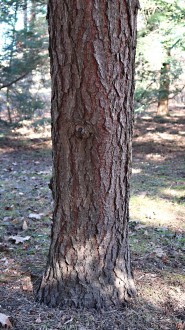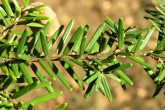(Tsuga caroliniana Engelm.)
Habitus
- wood growing to a height of 10 - 20 m
- crown narrow, conical, branches slightly overhanging
- bork grey-brown to brown, cracked into shorter longitudinal plates
Leaves (assimilation organs)
- assimilation organs are needle-like
- needles (leaves) are relatively short 10 - 13 x 1.5 - 2 mm in size, spirally arranged on the twig, grow on short petioles, stand on all sides
- needles are solidly edged, on the upper side dark green, shiny, on the lower side with two distinctly white bands of stomata
- at the end they are rounded or slightly cut
Flowers
- wood monoecious, flowers of different sexes
- ♂ cones are ovoid to spherical, 2 - 3 mm in size , first purple, later yellow, grow at the end of last year's shoots
- ♀ cones are greenish to reddish, ovoid, 3 - 5 mm in size, grow at the end of shoots
- it blooms III – IV
Fruits – seeds
- fruit is a cone, oblong-ovoid, 2.5 - 4 x 1.5 - 2 cm large, stalked, light brown when ripe
- the seed scales are rounded at the end, when ripe they open wide apart
- the seed is brown, ovoid, 3 - 4 mm large with a firmly attached with approx. 15 mm long, membranous wings
Extension
- North America, the center of distribution is the Appalachian Mountains at altitudes of 600 - 1,500 m above the sea level.
- creates mixed stands with Canadian hemlock (Tsuga canadensis), Scots pine (Pinus strobus) with oaks and other trees.
Ecology
- wood that is not demanding on the quality of the soil
- grows on rocky mountain slopes and in ravines
- tolerates shade
- more demanding on higher soil and air humidity
Significance
- an ornamental evergreen tree in parks and gardens
- produces several cultivars















